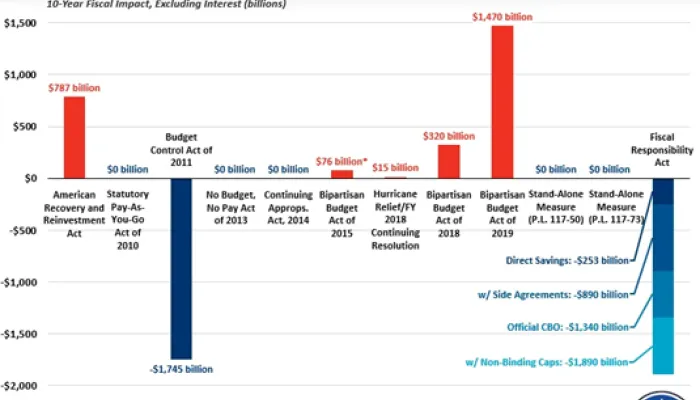Bill Hoagland: A Disappearing Budget Process Unhelpful for Fiscal Responsibility
G. William Hoagland is Senior Vice President at the Bipartisan Policy Center and member of the Committee for a Responsible Federal Budget. He previously held senior staff positions with the U.S. Senate Budget Committee and the Office of the Republican Majority Leader. He recently wrote a piece that appeared on Medium. It is reposted here.
As I look at what seems to be the end of the congressional budget process, I can’t help but think of my longtime mentor and friend, Senator Pete V. Domenici (R-NM), who passed away recently. He was the longest serving U.S. Senate Budget Committee chairman, and I believe he would have been just as disappointed as I am at the disappearing process for budgetary policymaking.
Chairman Domenici worked tirelessly from 1981 until giving up the gavel in 2002 to make the congressional budget process relevant in setting a fiscally responsible path for the country’s future. A strong Republican partisan fighting for what he believed was in the country’s best interest, he nonetheless was willing to work across the aisle with Democrats and Independents to compromise on taxes and spending in order to achieve a better economic future for the country. During his tenure either as Chairman or Ranking Member only once did Congress fail to agree to a budget to fund the U.S. government. In the 15 years since, Congress has failed eight times to come to an agreement.
Chairman Domenici’s crowning achievement came when he worked with President Clinton, House Budget Committee Chairman John Kasich (R-OH) and Democrats to enact the Balanced Budget Act of 1997 which led to the first balanced budget in over four decades.
The failure of the current budget process to set priorities and balance the public’s exhaustive demands with limited revenues, falls on both Republicans and Democrats. Budget resolutions once actually set funding priorities and balanced competing demands. The blueprints were generally adopted on time before the start of the fiscal year and drove consensus. Unbelievably, the very partisan budget resolution for the last fiscal year was adopted nearly 4 months after the fiscal year began. And Congress may similarly adopt a very partisan budget resolution for the current fiscal year at least 2 months after the fiscal year started.
Even worse, budget resolution numbers have become meaningless for debating national spending priorities. There was a time in the budget process when senators and House members spent weeks, not half days, actually discussing, debating and voting on spending on science, technology, education, health care, environment, international affairs and defense. In large part due to post-1974 laws which simply set the annual amount the federal government spends on appropriations (one-third of total federal spending), the original function of the budget committees to help set spending priorities has been neutered.
Today’s Senate and House budget resolutions magically assume that the budget will be balanced in 10 years. Not happening. The two resolutions assume spending for those annually appropriated domestic accounts will be reduced between $632 billion and $1.3 trillion respectively over the next decade with no real discussion of future priority needs or specific areas of reform.
Without any real sense of the policies that would be required to accomplish the task, the Senate and House budget resolutions simply assume between $3.6 trillion and $4.3 trillion reductions in programs such as Medicare, Medicaid, farm price supports, low-income housing and nutrition programs over the next decade. The Senate assumes these savings without any forcing mechanism to accomplish their savings, at least the House assumes $200 billion of the reductions would be forced through a budget reconciliation process. These “entitlement” programs must be controlled, but assuming that will happen does not make it so.
The seemingly sole purpose today of even having a budget resolution is to simply get around the 60-vote hurdle to avoid a filibuster in the U.S. Senate. The current Senate resolution’s one and only purpose is to allow for the expedited consideration of a tax reconciliation bill that could add at least $1.5 trillion to the burgeoning country’s debt.
Both Democrats and Republicans have mistreated and abused this reconciliation process that was never intended to be used for major, fundamental changes to public policy. Whether it be health care reform such as Obamacare that became law only because of the availability of a fast-track reconciliation bill or Republican efforts to undo Obamacare with a single shot reconciliation instruction in a “utility” 2017 budget resolution, using such a mechanism guarantees that highly partisan legislation emanating from this procedure will be unsustainable over time.
As one of the authors of the reconciliation process, Senator Robert Byrd (D-WV) admonished his colleagues in early 2009 that “the ironclad parliamentary procedures it (reconciliation) authorizes were never intended for this purpose” — health care reform, climate change, tax reform. Senator Byrd understood the limits of the budget process as did Senator Domenici.
It is painful to see a process that was meant to address the challenges of a modern economy become an instrument that is in fact adding to the polarization in Congress. It is painful to see a process that was designed to guide honest but tough decision making in Congress be abandoned for short-term political gains. Tax reform is necessary. But if Republicans use the reconciliation process to force a partisan tax bill through Congress, they may find, as did Democrats with Obamacare, that the reforms will not be sustainable over the long-term.
"My Views" are works published by members of the Committee for a Responsible Federal Budget, but they do not necessarily reflect the views of all members of the Committee.


